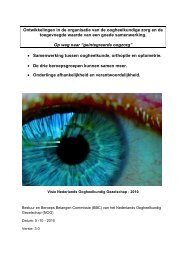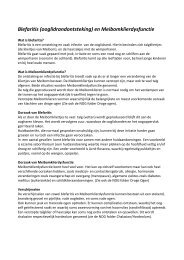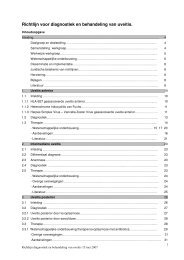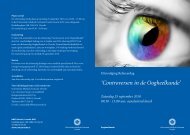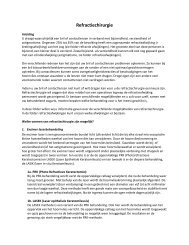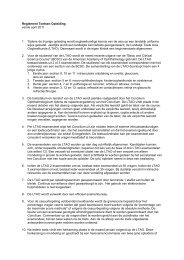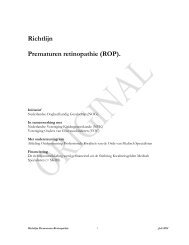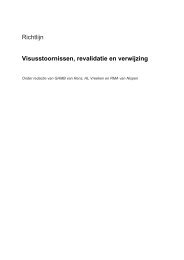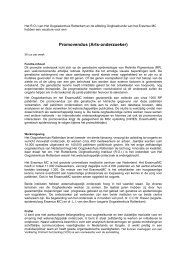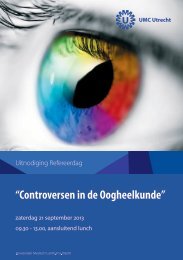terminology and guidelines for glaucoma ii - Kwaliteitskoepel
terminology and guidelines for glaucoma ii - Kwaliteitskoepel
terminology and guidelines for glaucoma ii - Kwaliteitskoepel
Create successful ePaper yourself
Turn your PDF publications into a flip-book with our unique Google optimized e-Paper software.
Features:<br />
Onset: typically third to fifth decades<br />
Frequency: 1-1.5 % of the total <strong>glaucoma</strong> cases, mostly Caucasians, more in myopic males<br />
One or both eyes<br />
Sign <strong>and</strong> symptoms:<br />
Uncommonly mild to moderate pain during acute episodes of IOP rise. Haloes around lights.<br />
IOP: > 21 mm Hg, characteristically with large variations. Significant increase may occur after exercise, pupillary<br />
dilation or blinking. Gradual decrease of IOP with age over 60 years has been reported.<br />
Slit lamp examination: deep anterior chamber, midperipheral iris pigment epithelial atrophy with radial pattern especially<br />
well visible with retroillumination. Pigment dispersed on the trabecular meshwork, Schwalbe’s line, the iris surface, the<br />
lens equator <strong>and</strong> on the corneal endothelium, where often shapes itself as a central, vertical spindle (Krukenberg’s spindle).<br />
Dim light in the examination room is recommended, in order to enhance the observation of the peripheral iris shape. UBM<br />
examination is often helpful to diagnose reverse pupillary block.<br />
2.3.1.3 - Lens-induced Secondary Open-Angle Glaucoma<br />
Etiology: Obstruction of the trabecular meshwork by lens proteins <strong>and</strong>/or inflammatory cells induced by lens proteins.<br />
Pathomechanism:<br />
• Lens proteins from a mature or hypermature cataract with intact capsule (phacolytic <strong>glaucoma</strong>)<br />
• Lens particles from a traumatically or surgically injured lens (lens particle <strong>glaucoma</strong>)<br />
• Granulomatous inflammation of the TM after uneventful ECCE when the fellow eye was already operated <strong>and</strong><br />
its lens proteins sensitized the immune system (phacoanaphylactic <strong>glaucoma</strong>)<br />
Features:<br />
Age of onset <strong>and</strong> acute or chronic course depend on the pathomechanism<br />
Sign <strong>and</strong> symptoms:<br />
Often painful with redness <strong>and</strong> inflammation<br />
IOP > 21 mm Hg<br />
Slit lamp examination: injured lens <strong>and</strong>/or cataract or after ECCE, with or without iritis<br />
2.3.1.4 - Glaucoma associated with intraocular haemorrhage<br />
Etiology: Obstruction of the trabecular meshwork by rigid red blood cells (ghost cell <strong>glaucoma</strong>, Sickle cell disease) or by a<br />
large quantity of normal red blood cells (hyphaema).<br />
Pathomechanism: Red blood cells (ghost cells) from an old vitreous hemorrhage, via a ruptured anterior hyaloid face, or<br />
from the iris (<strong>for</strong> example trauma, intraocular surgery) obstruct the trabecular meshwork<br />
Features:<br />
Sign <strong>and</strong> symptoms:<br />
Pain, redness, recurrences possible<br />
IOP > 21 mm Hg<br />
2.3.1.5 - Uveitic Glaucoma<br />
Etiology: Several <strong>for</strong>ms of anterior <strong>and</strong> intermediate uveitis can cause unilateral or bilateral obstruction of the trabecular<br />
meshwork. The most frequent conditions are juvenile rheumatoid arthritis, Fuchs’ heterochromic iridocyclitis, Posner-<br />
Schlossman syndrome (<strong>glaucoma</strong>tocyclitic crisis), herpes simplex, herpes zoster, syphilis, sarcoidosis, Behçet disease, sympathetic<br />
ophthalmia, pars planitis.<br />
Pathomechanism: Obstruction <strong>and</strong> edema of the trabecular meshwork caused by inflammatory cells, precipitates, debris,<br />
secondary scarring <strong>and</strong> neovascularization of the chamber angle. Secondary angle-closure <strong>glaucoma</strong> due to synechiae can<br />
also develop.<br />
Features:<br />
Onset depends on underlying condition. Any age<br />
Sign <strong>and</strong> symptoms:<br />
Pain, redness, photophobia, decreased vision are possible.<br />
IOP > 21 mm Hg. Some <strong>for</strong>ms are associated with wide oscillations or periodic rise of IOP.<br />
Ch. 2 - 10 EGS



